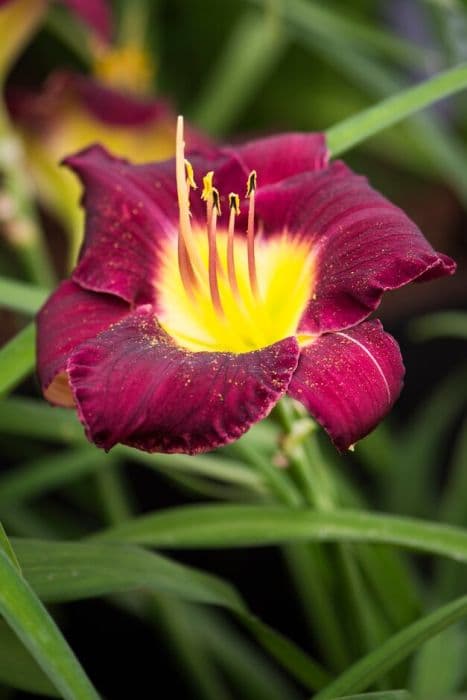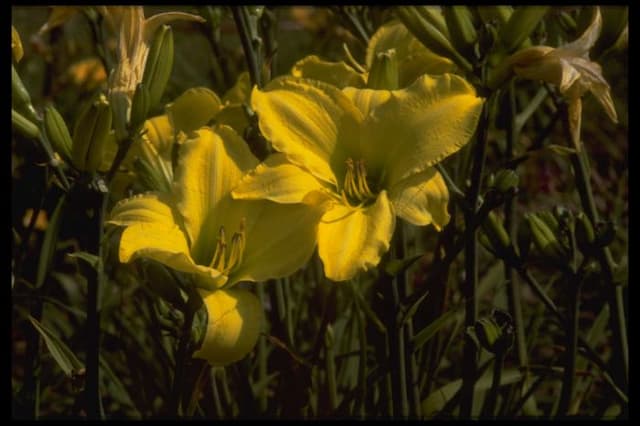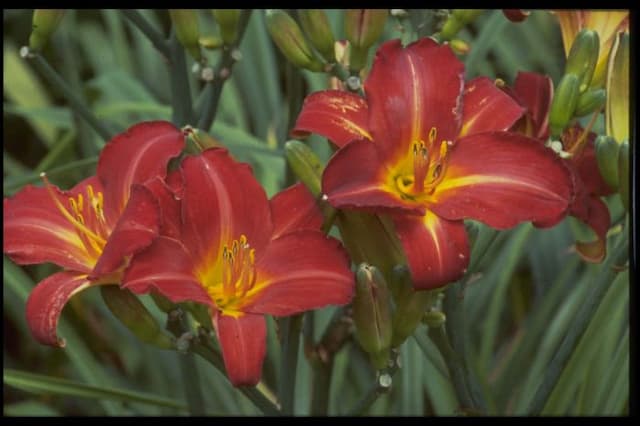Daylily Hemerocallis 'Eenie Weenie'

ABOUT
The Hemerocallis 'Eenie Weenie', commonly known as the daylily, is a charming and vibrant flowering plant. It bears a compelling display of small, trumpet-shaped flowers that are a vivid shade of yellow with a striking throat of a lighter tone, adding a sense of depth and contrast to the bloom. Each flower consists of six broad, petal-like segments that gracefully recurve away from the center, giving it a casual yet sophisticated appeal. The texture of the petals can be described as slightly ruffled, which provides an additional element of visual interest. The foliage of the daylily is equally attractive, forming an elegant clump of long, slender leaves. The leaves are a fresh shade of green that remains lush throughout the growing season, adding to the plant's loveliness even when it is not in bloom. The daylily is known for its hardiness and ability to produce an abundance of blooms over an extended period, often surprising onlookers with fresh flowers day after day during its blooming season. Overall, the daylily 'Eenie Weenie' presents itself as a cheerful addition to any garden space, with its bewitching yellow flowers bringing a burst of sunshine to the landscape. It's a plant that pairs well with a variety of other garden species, adding its own unique splash of color and texture to garden beds, borders, and containers.
About this plant
 Names
NamesFamily
Hemerocallidaceae
Synonyms
Daylily, Dwarf Daylily
Common names
Hemerocallis 'Eenie Weenie'.
 Toxicity
ToxicityTo humans
The Daylily, represented by the cultivar Hemerocallis 'Eenie Weenie', is not considered toxic to humans. In fact, certain parts of daylilies are commonly eaten in some cultures, and the flowers are sometimes used in culinary dishes. However, it's important to note that while the daylily may not be toxic, it can be easily confused with other lilies that are toxic, such as true lilies (Lilium spp.) which are highly toxic and can cause severe symptoms if ingested. Always be sure to correctly identify the plant before considering consumption.
To pets
Daylilies are toxic to cats, with the potential to cause severe symptoms. If a cat ingests any part of a daylily, it can result in acute kidney failure, which is a life-threatening condition. Symptoms of poisoning in cats may include vomiting, lethargy, appetite loss, and kidney failure signs such as decreased urination, increased thirst, and abdominal pain. It is crucial for cat owners to prevent their pets from having access to daylilies. If ingestion occurs, immediate veterinary attention is required. Although they are toxic to cats, daylilies are not known to be toxic to dogs or other pets. Nevertheless, it's always best to prevent any pet from ingesting plants not specifically intended for them.
 Characteristics
CharacteristicsLife cycle
Perennials
Foliage type
Deciduous
Color of leaves
Green
Flower color
Yellow
Height
1 foot (30 cm)
Spread
1 foot (30 cm)
Plant type
Herb
Hardiness zones
3
Native area
Asia
Benefits
 General Benefits
General Benefits- Easy to Grow: Thrives in a variety of soil conditions and requires minimal care once established.
- Drought Tolerant: Once established, it has good resistance to dry periods, making it suitable for xeriscaping or low-water gardens.
- Attracts Pollinators: Flowers provide nectar and attract butterflies, bees, and other beneficial insects to the garden.
- Long Blooming: Offers vibrant yellow blooms that can last from early summer to early fall, enhancing garden color for an extended period.
- Edible Flowers: Blossoms are edible and can be used in salads, as garnish, or for other culinary decoration.
- Compact Size: The 'Eenie Weenie' variety is smaller and more compact than other daylilies, making it ideal for borders, pots, and small gardens.
- Rapid Growth: Fast-growing nature allows for quick establishment and filling in of garden spaces.
- Pest Resistance: Generally resistant to many pests and diseases, reducing the need for chemical treatments.
- Division Propagation: Can be easily propagated by division, which is economical and allows for expanding the garden or sharing with others.
- Versatile Landscape Use: Suitable for mass plantings, borders, and as accent plants, providing flexibility in garden design and landscaping.
 Medical Properties
Medical PropertiesThis plant is not used for medical purposes.
 Air-purifying Qualities
Air-purifying QualitiesThis plant is not specifically known for air purifying qualities.
 Other Uses
Other Uses- Artistic Inspiration: Daylilies like 'Eenie Weenie' often serve as a subject for botanical illustration and watercolor painting due to their vibrant colors and delicate forms.
- Culinary Decoration: The blooms of the daylily can be used as edible garnishes on cakes and pastries to add a touch of elegance and color.
- Photography: Their bright and cheerful appearance makes daylilies, including 'Eenie Weenie', a popular choice among photographers for nature and garden photography.
- Fabric Dye: Historically, some daylilies have been used to create natural dyes for fabrics, though it's essential to verify the safety and effectiveness for each specific cultivar.
- Floral Arrangements: Daylily flowers can be cut and used in floral arrangements to provide a temporary splash of color indoors.
- Companion Planting: Daylilies can be used in vegetable gardens as companion plants; their roots can help to condition the soil and their blooms to attract pollinators.
- Wedding Décor: The flowers of 'Eenie Weenie' are sometimes incorporated into wedding decor for bouquets, table arrangements, and as part of the ceremony backdrop due to their symbolism of motherhood and fertility.
- Educational Tool: In schools or educational programs, daylilies can be cultivated to teach students about plant biology, life cycles, and gardening.
- Crafts: The dried blooms of the daylily can be incorporated into crafts such as making potpourri, bookmarks, and pressed flower decorations.
- Garden Borders: Due to their compact size, 'Eenie Weenie' daylilies are excellent for creating low borders or edging in garden design.
Interesting Facts
 Feng Shui
Feng ShuiThe daylily is not used in Feng Shui practice.
 Zodiac Sign Compitability
Zodiac Sign CompitabilityThe daylily is not used in astrology practice.
 Plant Symbolism
Plant Symbolism- Longevity and Renewal: Daylilies, in general, symbolize longevity due to their ability to bloom over a long period and the fact that each flower typically lasts for just one day – suggesting renewal and the cycle of life.
- Motherhood: In Chinese culture, daylilies are associated with motherhood and the devotion of mothers because of the plant's nurturing way of producing numerous offspring through its plentiful flowers.
- Forgetfulness and Loss: The ephemeral nature of each bloom, lasting only a single day, can also be symbolic of forgetfulness and the fleeting nature of life, reminding us of loss and the passage of time.
- Adaptability: Given the plant's ability to thrive in a variety of conditions, the daylily can represent adaptability and the ability to endure changing environments.
 Water
WaterThe daylily, commonly known as Hemerocallis 'Eenie Weenie', should be watered deeply once a week during active growth, ensuring that the soil is thoroughly moistened. During particularly dry spells, increase watering to twice per week. Each watering session should involve approximately 1 gallon of water per plant, ensuring water reaches the root zone. Water in the morning to allow excess moisture on foliage to evaporate during the day, reducing the risk of fungal diseases. Decrease watering frequency as the plant goes dormant in the late fall and winter months.
 Light
LightDaylilies, like Hemerocallis 'Eenie Weenie', thrive in full sunlight, requiring at least six hours of direct sun daily. Though they can tolerate some light shade, especially in hotter regions, too much shade can reduce blooming and weaken the plant. The ideal spot for 'Eenie Weenie' daylilies is in a garden area where they can enjoy the morning sun, which is less intense and helps flowers last longer.
 Temperature
TemperatureDaylilies, including Hemerocallis 'Eenie Weenie', prefer moderate temperatures and can generally survive in temperatures ranging from 20°F to 90°F. They perform best in temperatures between 40°F and 85°F. These plants are hardy and can tolerate the occasional cold snap or heat wave, but optimal growth and blooming occur within their ideal temperature range.
 Pruning
PruningPruning daylilies like Hemerocallis 'Eenie Weenie' involves removing spent flower stalks (scape) and dead foliage to encourage reblooming and maintain a tidy appearance. Prune as needed throughout the blooming season, which typically spans from late spring to late summer. The best time for a significant cleanup is early spring or after the plant has finished blooming, which can stimulate new growth.
 Cleaning
CleaningAs needed
 Soil
SoilThe best soil mix for the Daylily 'Eenie Weenie' is well-draining soil with plenty of organic matter such as compost or peat moss. A soil pH of 6.0 to 6.5 is optimal for the growth of this plant. It's essential that the soil is not too heavy or clayey, as good drainage is crucial to prevent root rot.
 Repotting
RepottingDaylily 'Eenie Weenie' does not generally require frequent repotting as it is a perennial garden plant. It can be divided every 3 to 5 years to rejuvenate its growth and spread. When repotting, choose a larger container if growing in pots and replenish with fresh soil mix.
 Humidity & Misting
Humidity & MistingDaylily 'Eenie Weenie' is tolerant of a wide range of humidity levels and does not require any special humidity conditions. It can thrive in the varying outdoor humidity levels found in its hardiness zones.
 Suitable locations
Suitable locationsIndoor
Place in bright, indirect light and ensure good airflow.
Outdoor
Full sun to partial shade, fertile soil, water regularly.
Hardiness zone
3-9 USDA
 Life cycle
Life cycleThe life of the Daylily 'Eenie Weenie' begins with germination, where the plant emerges from seeds or grows from rhizomatous roots. It moves into vegetative growth, developing long, strap-like leaves and establishing a strong root system. As it matures, it enters the reproductive phase, producing numerous small, yellow flowers on stalks above the foliage during the late spring to early summer. After blooming, which lasts for just a day per flower, it sets seed capsules if pollination has occurred. The plant then returns to a focus on vegetative growth to store energy for the next season. During winter or periods of dormancy, the foliage may die back, particularly in colder climates, with the roots remaining alive underground to sprout again when conditions are favorable.
 Propogation
PropogationPropogation time
Spring to early summer
Propogation: The most popular method of propagating the Daylily 'Eenie Weenie' is by division. This is best done after the flowering period, usually in the fall, which is ideal to allow the plants time to establish before winter. To propagate by division, carefully dig up the clump of daylilies and gently separate the individual fans of leaves, ensuring each division has at least a few leaves and its own root system. Replant the divisions immediately, spacing them about 12 to 18 inches apart (approximately 30 to 45 centimeters), at the same depth they were previously. Water the new transplants thoroughly to help them establish in their new location.









